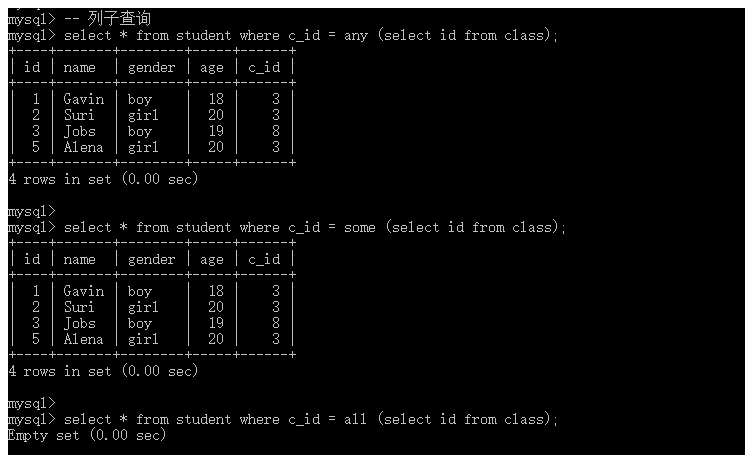子查询:sub query,查询是在某个查询结果之上进行的,一条select语句内部包含了另外一条select语句。
分类
子查询有两种分类方式,分别为:按按结果分类和位置分类。
按结果分类,即根据子查询得到的数据进行分类(理论上,任何一个查询结果都可以理解为一个二维表),分别为:
- 标量子查询:子查询得到的结果是一行一列,出现的位置在
where之后; - 列子查询:子查询得到的结果是一列多行,出现的位置在
where之后; - 行子查询:子查询得到的结果是多行一列(多行多列),出现的位置在
where之后; - 表子查询:子查询得到的结果是多行多列,出现的位置在
from之后。
按位置分类,即根据子查询(select语句)在外部查询(select语句)中出现的位置进行分类,分别为:
-
from子查询:子查询出现在from之后; -
where子查询:子查询出现在where条件之中; -
exists子查询:子查询出现在exists里面。
标量子查询
需求:现知道班级名称为PM3.1,想要获取该班的全部学生。
思路:
- 先确定数据源,学生表。
select * from student where c_id = ?;- 然后获取班级 ID,可以通过(班级表)班级名称来确定。
select id from class where grade = "PM3.1";
执行如下 SQL 语句,进行测试:
-- 标量子查询 select * from student where c_id = (select id from class where grade = "PM3.1");
列子查询
需求:查询所有在读班级(学生表中存在的班级)的学生。
思路:
- 先确定数据源,学生表。
select * from student where c_id in ?;- 然后确定全部有效的班级 ID。
select id from class;
执行如下 SQL 语句,进行测试:
-- 列子查询 select * from student where c_id in (select id from class);

如上图所示,我们完成了列子查询。在列子查询的结果为一行多列时,我们需要使用in作为条件进行匹配;此外,在 MySQL 中还有三个类似的条件,分别为:all、some和any。
-
any等价于in,表示其中一个; -
any等价于smoe,而any和some用于否定时却有些区别; -
all表示等于全部。
值得注意的是,在我们使用上面三个关键字中任何一个的时候,都需要搭配=使用,例如:
-- 列子查询 select * from student where c_id = any (select id from class); select * from student where c_id = some (select id from class); select * from student where c_id = all (select id from class);

如上图所示,为any、some和all的肯定用法,下面我们来测试其否定用法:
-- 列子查询 select * from student where c_id != any (select id from class); select * from student where c_id != some (select id from class); select * from student where c_id != all (select id from class);

观察上图,我们会发现any、some和all在用于否定时,其会将null值排除掉。实际上,在真正的开发中,这三个关键字并不常用。
行子查询
行子查询,返回的结果可以使一行多列或者多行多列。
需求:查询学生表中,年龄最大且身高最高的学生。
思路:
- 先确定数据源,学生表。
select * from student where age = ? and height = ?;- 然后确定最大年龄和最大身高。
select max(age), max(height) from student;
执行如下 SQL 语句,进行测试:
-- 列子查询 select * from student where -- 其中,(age, height) 称之为行元素 (age, height) = (select max(age), max(height) from student);

表子查询
表子查询,返回的结果是多行多列二维表(将子查询的结果当做二维表来使用),实际上,任何查询返回的结果都可以称之为二维表。
需求:找出每个班身高最高的学生。
思路:
- 先确定数据源,将学生按身高进行降序排序。
select * from student order by height desc;- 从每个班级选出第一个学生。
select * from student group by c_id;
在这里,我们可能会有些疑问:为什么要将学生表降序排序?为什么从每个班级选出第一个学生就可以?这是因为group by(分组)只会取表中分组字段的第一条记录,而当我们将学生表按身高降序排序时,(每组)身高最高的学生就会出现在第一位。
执行如下 SQL 语句,进行测试:
-- 表子查询 select * from -- 关键字 from 后面接表名 (select * from student order by height desc) as student -- 按 c_id 进行分组 group by c_id;
由上面的 SQL 语句可知,表子查询也是from子查询,即有select语句位于from之后。
exists子查询
exists:表示是否存在的意思,因此exists子查询就是用来判断某些条件是否满足(跨表),exists是接在where之后,其返回的结果为1或0,满足条件为1,反之为0.
需求:在班级存在的前提下,查询所有的学生。
思路:
- 先确定数据源。
select * from student where ?;- 然后确定条件是否满足。
exists(select * from class);
执行如下 SQL 语句,进行测试:
-- exists 子查询 select * from student where exists(select * from class); -- 添加限定条件,满足条件 select * from student where exists(select * from class where id = 3); -- 添加限定条件,不满足条件 select * from student where exists(select * from class where id = 100);
至此,我们已经将子查询学习完啦!也许大家还会有些疑惑,那就是到底在什么时候用什么子查询?对于这个问题,我们不用过于纠结,因为这根本就是我们要用什么子查询的问题,而是根据实际需求,我们将查询返回的结果按形式命名的称呼而已。
温馨提示:符号[]括起来的内容,表示可选项;符号+,则表示连接的意思。










